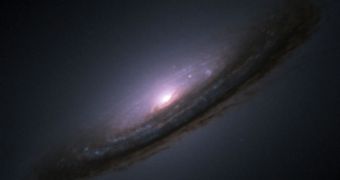This hypothetical form of energy is supposed to fill all the space and it continuously pushes its elements apart, increasing the universe's expansion rate. It is one of the most important things that LHC scientists are eager to prove.
The standard model of cosmology claims that the universe is comprised 74% of dark energy and 22% of cold dark matter. This means that only 4% is made from the matter we know about, the one that gives birth to the atoms and photons that form stars, planets, black holes or gaseous clouds. Astonishing, isn't it? But if you think about it for a bit, it's kind of logical, since not so much of the space is really occupied with material bodies. There are vast "fields of nothing" out there.
We sort of got an idea of what dark energy is about, now let's see what the rest of those weird terms mean. The previously mentioned standard model of cosmology is also known as Lambda-Cold Dark Matter (LCDM) model or the concordance model of big bang cosmology. Lambda refers to the cosmological constant, a term linked to the increasing expansion rate of the universe.
The Cold Dark Matter model states that dark mater is: cold (obviously, which means, in fact, that its speed is non-relativistic, not related to the speed of light), dissipationless (can't be cooled by photon radiation), non-baryonic and collisionless (its particles only interact with each other and with other particles by means of gravity). Hadrons are made of quarks (a basic particle that interacts via the 4 fundamental forces: gravitation, electromagnetism, the weak and the strong interaction). Baryons are a subgroup of hadrons made of 3 quarks.
Once again: the things related to dark matter and dark energy are only theoretical, based on observations of very distant space objects, such as Ia supernovae. Around 1990, they were noticed to be pushed further away, against all gravity, and even at increasing speed, which demolished the previous assumption that the universe has been slowing down since the Big Bang.
Trials
Nowadays, besides the LHC that everybody seems to talk about lately, there are also many other devices that are trying to gather data about the source and nature of dark energy, in different ways, by exploring the universe "out there." One such machine is the Hobby Eberly Telescope Dark Energy Experiment (HETDEX) at the McDonald Observatory in Texas. Its purpose is to look beyond the Ia supernovae (9 billion "years" away), at space places and bodies situated 10 to 12 billion light years from Earth. People running it, Professor Karl Gebhardt and Senior Research Scientists, Dr. Phillip McQueen and Dr. Gary Hill, are very confident that HETDEX will do its job well.
"We’ve designed an upgrade that allows the HET to observe 30 times more sky at a time than it is currently able to do. Essentially we are just making a very big map [across some 15 billion cubic light years] of where the galaxies are and then analyzing that map to reveal the characteristic patterns," states Hill. "In the very early Universe, matter was spread out in peaks and troughs, like ripples on a pond, galaxies that later formed inherited that pattern," adds Gebhardt. The telescope will be able to map 10.000 galaxies each night. The map will show very precisely the rate at which the universe extends. "Since dark energy only manifests itself in the expansion of the universe, HETDEX will measure the effect of dark energy to within one percent. If dark energy’s contribution to the expansion of the universe has changed over time, we expect HETDEX to see the change [in its observations]. Such a result will have profound implications for the nature of dark energy, since it will be something significantly different than what Einstein proposed," concludes the scientist.
There are also dozens of other projects and devices with the same goal. Adept (Advanced Dark Energy Physics Telescope), led by Charles Bennett from Johns Hopkins University in Baltimore, will study near-infrared light from 100 million galaxies and 1.000 Ia supernovae, same as SNAP (SuperNova/Acceleration Probe), Saul Perlmutter's project at Lawrence Berkeley National Laboratory in Berkeley, California. The Dark Energy Survey is an international project that plans to develop a 1 m diameter 500 megapixel camera and to plant it on the 4-meter Blanco telescope at Cerro Tololo Inter-American Observatory.
With all these research efforts going on, we can only encourage dark energy to be there somewhere, so that the people involved in its discovery may be content some day. Imagine how many people will need to find other jobs if LHC discovers dark matter and/or dark energy.
Speaking of which, first "Chuck Norris-like" jokes targeted LHC recently on Wired: "LHC is the new Anthrax. LHC is the new 9/11. LHC is the new Red Scare. LHC is hiding in your closet. LHC is under your bed," (lisardggY). "The LHC killed JFK and Martin Luther KIng. It also invented Milk Duds and black licorice. That's just what I heard..." (infogasm). "The LHC can only be to blame for my very weird dreams last night. In case they weren't dreams, watch out for the gibbon-people." (aquaphase). "Guys, there's a black hole in my office. It's called Outlook. I blame the LHC." (BrotherMagneto). "My monitor just randomly shut off… was going to blame the LHC, then I realized my dog turned off my power strip." (darronschall).

 14 DAY TRIAL //
14 DAY TRIAL //